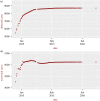New methodologies for the estimation of population vulnerability to diseases: a case study of Lassa fever and Ebola in Nigeria and Sierra Leone
- PMID: 31104602
- PMCID: PMC6558567
- DOI: 10.1098/rstb.2018.0265
New methodologies for the estimation of population vulnerability to diseases: a case study of Lassa fever and Ebola in Nigeria and Sierra Leone
Abstract
Public health practitioners require measures to evaluate how vulnerable populations are to diseases, especially for zoonoses (i.e. diseases transmitted from animals to humans) given their pandemic potential. These measures would be valuable to support strategic and operational decision making and allocation of resources. Although vulnerability is well defined for natural hazards, for public health threats the concept remains undetermined. Here, we develop new methodologies to: (i) quantify the impact of zoonotic diseases and the capacity of countries to cope with these diseases, and (ii) combine these two measures (impact and capacity) into one overall vulnerability indicator. The adaptive capacity is calculated from estimations of disease mortality, although the method can be adapted for diseases with no or low mortality but high morbidity. As an example, we focused on the vulnerability of Nigeria and Sierra Leone to Lassa Fever and Ebola. We develop a simple analytical form that can be used to estimate vulnerability scores for different spatial units of interest, e.g. countries or regions. We show how some populations can be highly vulnerable despite low impact threats. We finally outline future research to more comprehensively inform vulnerability with the incorporation of relevant factors depicting local heterogeneities (e.g. bio-physical and socio-economic factors). This article is part of the theme issue 'Modelling infectious disease outbreaks in humans, animals and plants: epidemic forecasting and control'. This theme issue is linked with the earlier issue 'Modelling infectious disease outbreaks in humans, animals and plants: approaches and important themes'.
Keywords: adaptive capacity; impact; mathematical modelling; zoonosis.
Conflict of interest statement
The authors declare no competing interests.
Figures




Similar articles
-
Health seeking behavior after the 2013-16 Ebola epidemic: Lassa fever as a metric of persistent changes in Kenema District, Sierra Leone.PLoS Negl Trop Dis. 2021 Jul 14;15(7):e0009576. doi: 10.1371/journal.pntd.0009576. eCollection 2021 Jul. PLoS Negl Trop Dis. 2021. PMID: 34260615 Free PMC article.
-
Quantifying the seasonal drivers of transmission for Lassa fever in Nigeria.Philos Trans R Soc Lond B Biol Sci. 2019 Jun 24;374(1775):20180268. doi: 10.1098/rstb.2018.0268. Philos Trans R Soc Lond B Biol Sci. 2019. PMID: 31056054 Free PMC article.
-
Re-emerging Lassa fever outbreaks in Nigeria: Re-enforcing "One Health" community surveillance and emergency response practice.Infect Dis Poverty. 2018 Apr 28;7(1):37. doi: 10.1186/s40249-018-0421-8. Infect Dis Poverty. 2018. PMID: 29703243 Free PMC article.
-
[Ebola hemorrhagic fever: its extension reflects the African sanitary disaster].Rev Prat. 2014 Sep;64(7):905-10. Rev Prat. 2014. PMID: 25362763 Review. French.
-
[Emerging infectious diseases--Ebola hemorrhagic fever].Nihon Naika Gakkai Zasshi. 1997 Nov 10;86(11):2016-22. Nihon Naika Gakkai Zasshi. 1997. PMID: 9480303 Review. Japanese. No abstract available.
Cited by
-
Lassa Fever: An Evolving Emergency in West Africa.Am J Trop Med Hyg. 2020 Nov 23;104(2):466-473. doi: 10.4269/ajtmh.20-0487. Am J Trop Med Hyg. 2020. PMID: 33236712 Free PMC article. Review.
-
Preface to theme issue 'Modelling infectious disease outbreaks in humans, animals and plants: epidemic forecasting and control'.Philos Trans R Soc Lond B Biol Sci. 2019 Jul 8;374(1776):20190375. doi: 10.1098/rstb.2019.0375. Philos Trans R Soc Lond B Biol Sci. 2019. PMID: 31104610 Free PMC article.
-
Discovery and Genetic Characterization of Novel Paramyxoviruses Related to the Genus Henipavirus in Crocidura Species in the Republic of Korea.Viruses. 2021 Oct 7;13(10):2020. doi: 10.3390/v13102020. Viruses. 2021. PMID: 34696450 Free PMC article.
-
Detection, forecasting and control of infectious disease epidemics: modelling outbreaks in humans, animals and plants.Philos Trans R Soc Lond B Biol Sci. 2019 Jun 24;374(1775):20190038. doi: 10.1098/rstb.2019.0038. Philos Trans R Soc Lond B Biol Sci. 2019. PMID: 31056051 Free PMC article.
References
-
- Fleming L. et al. 2018. Beyond climate change and health: integrating broader environmental change and natural environments for public health protection and promotion in the UK. Atmosphere 9, 245 (10.3390/atmos9070245) - DOI
-
- Adger WN. 2006. Vulnerability. Glob. Environ. Change 16, 268–281. (10.1016/j.gloenvcha.2006.02.006) - DOI
-
- Gallopín GC. 2006. Linkages between vulnerability, resilience, and adaptive capacity. Glob. Environ. Change 16, 293–303. (10.1016/j.gloenvcha.2006.02.004) - DOI
Publication types
MeSH terms
Associated data
LinkOut - more resources
Full Text Sources
Medical
Research Materials

